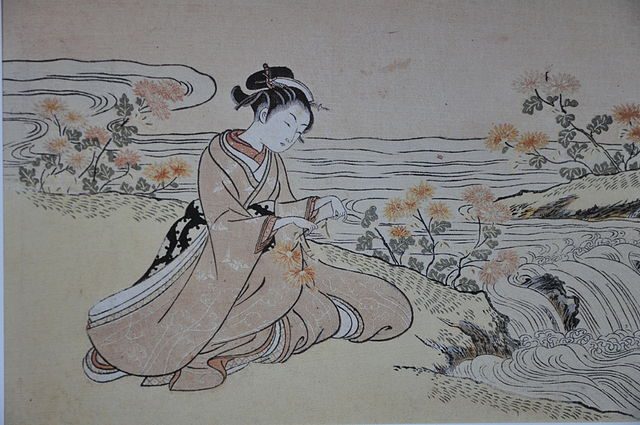Japan art and Suzuki Harunobu (1725-1770): Ladies and style
Lee Jay Walker
Modern Tokyo Times

The Japanese artist Suzuki Harunobu (1725-1770) became the most potent artist depicting beautiful ladies (bijin-ga) in the 1760s. Initially, Harunobu was inspired by Nishikawa Sukenobu. However, in time he developed his own distinctive style.
Harunobu was instrumental in Nishiki-e (multi-colored woodblock printing). This new multi-colored woodblock printing world – that emerged in the 1760s – rendered the two to three-color prints with being dated. Therefore, his already stunning art of beautiful ladies was enhanced dramatically by the new color schemes that became available.

Little his known about his early life. Hence, it is like a jigsaw is trying to fill in the gaps. Yet, sadly for Harunobu, it is known that he was reaching the peak of his popularity when he died.
The British Museum says, “The leading artist of prints of beautiful women in the 1760s, Harunobu originally based his style on that of Nishikawa Sukenobu but gradually became more individual. He participated as an artist in the parties to exchange calendar prints in 1765 and 1766, and became the most important designer of prints of beauties as a result of his major contribution to the establishment of the full color’ nishikie’ print. He was a prolific artist of ‘chuban’ prints showing the manners and customs of women, and completely dominated his generation, giving rise to many imitators. The special qualities of Harunobu’s prints are their lyricism and purity of feeling; he invites the viewer into a special, dreamlike world.”

Harunobu’s focus was on the lady in his bijin-ga art pieces. Thus the eye doesn’t fixate on the delightful color and designs of the kimono. Instead, the focus is on the ladies depicted in his art concerning their thin and mild features.
Richard Lane (1926-2002) said, “Harunobu’s special province, one in which he surpassed all other Japanese artists – eternal girlhood in unusual and poetic settings.”

In the above art piece, the Met Museum says, “Of all ukiyo-e prints of lovers, this one creates the most romantic and melancholic mood. Harunobu emphasizes the intimacy of two lovers strolling in the snow, even suggesting perhaps a michiyuki, a path to a love suicide. The couple walk together in the quietly falling snow, in what is known as an ai ai gasa pose, literally, the sharing of an umbrella and love.”

Modern Tokyo News is part of the Modern Tokyo Times group
DONATIONS to SUPPORT MODERN TOKYO TIMES – please pay PayPal and DONATE to sawakoart@gmail.com
http://moderntokyotimes.com Modern Tokyo Times – International News and Japan News
http://sawakoart.com – Sawako Utsumi personal website and Modern Tokyo Times artist
https://moderntokyonews.com Modern Tokyo News – Tokyo News and International News
http://global-security-news.com Global Security News – Geopolitics and Terrorism
PLEASE JOIN ON TWITTER
https://twitter.com/MTT_News Modern Tokyo Times
PLEASE JOIN ON FACEBOOK